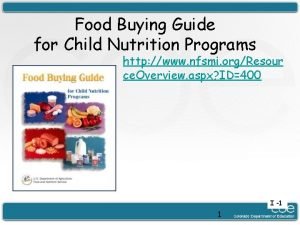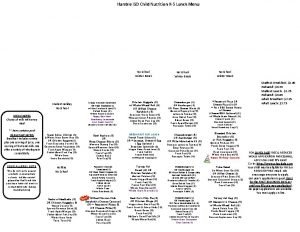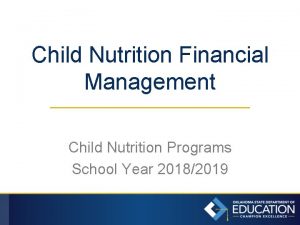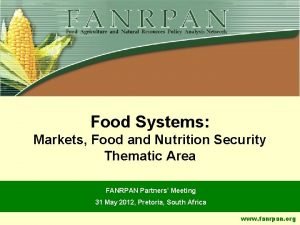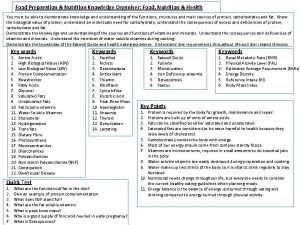Rural food markets and child nutrition Derek Headey













- Slides: 13

Rural food markets and child nutrition Derek Headey 1, Kalle Hirvonen 1, John Hoddinott 2 and David Stifel 3 Presentation for AAEA/ASSA meetings January 2019 1 International Food Policy Research Institute 2 Cornell University 3 Lafayette College

Introduction • Improving the diets of pre-school children’s children has intrinsic and instrumental value • Increasingly, attention has focused on improving dietary quality, particularly the consumption of foods rich in animal-sourced proteins and micro-nutrients when children are 6 -23 months old • Alongside behavior change communication activities, interventions aimed at improving child diets have emphasized diversifying household food production, particularly via the cultivation of homestead garden plots and small-scale dairy and poultry operations.

Introduction • The logic of these approaches is twofold. • First, child undernutrition still remains a predominantly rural problem in lowincome countries, especially Africa. • Second, since most rural households in low income countries still predominantly depend on farming, agricultural diversification could improve diets either through increasing cash income from the sale of high value foods, or through improving access to non-staple foods that are expensive or unavailable in markets. • There are more than 40 studies that document associations between household production diversity and diversity of household diets. Systematic reviews of this literature: • Find “small but consistent associations” (Jones 2017), but • “Little evidence to support the assumption that increasing farm production diversity is a highly effective strategy to improve smallholder diets” (Sibhatu and Qaim 2018)

Introduction: Contribution of paper • A limitation of much of this literature is that it ignores the role of markets • Studies that do include measures of market access tend to use crude indicators (eg “distance to market”) • We seek to redress this limitation through the use of observational data linking rural food markets to children’s diet. – Are market characteristics (diversity, availability, affordability) associated with the quality of children’s diets?

Data: General • Two rounds of survey data collected in 2017, March and August (lean season), in four Highland regions of Ethiopia (Amhara, Oromia, SNNP, Tigray) • Sample consists of children aged 6 -24 months (March, n=1888) and 6 -30 months (August, n=2, 398) living in 88 woredas and 264 kebeles • Data collected on: – Child diets, yes/no questions on consumption of specified food groups in previous day (WHO standard protocol) – Maternal and household characteristics – Kebele characteristics – Market characteristics at the kebele level (number of sellers; days of operation; infrastructure; prices and availability of 71 unique foods)

Data: Food groups consumed previous day, pooled data Dietary 4 or more Grains, Diversity food roots Score groups and tubers Legumes and nuts Dairy Mean Meat, fish, poultry (Flesh foods) Eggs Vitamin A Other fruit rich fruit and veg Percent Non grain food groups Mean All children 1. 6 5 80 26 13 1 5 8 29 0. 8 34 1. 0 Children who consumed at least one food group 1. 9 6 96 31 15 1 6 10

Data: Market characteristics • Most markets (76%) are large with more than 50 traders selling food and operate 1 -2 days per week. A majority (~76%) have bus service and electricity. Cell phone coverage is nearly universal. • Markets are “incomplete” • All markets sell at least one grain, root or tuber, and virtually all (>95%) sell other (non-vitamin A-rich) vegetables, eggs and legumes. 89% sell other fruits and 83% sell vitamin A-rich fruits or vegetables • But only 74% of markets sell nuts, while just 45% sell dairy products and 44% sell meat, poultry, fish • Average market sells 7. 6 different staples, 4. 2 -4. 8 legumes and nuts but fewer than one dairy product and between 0. 5 and 1. 2 flesh foods. Only 35. 2% in the March round and just 16. 7% in the August round sold all 6 non-staple food groups. 44% sell four or fewer non-staple food groups.

Data: Calorie-Price Ratios

Model DIETihwkt = βMARKET ∙ MARKETkwt (foods sold, # vendors, days operate, bus service, cost of cheapest cereals) + βCHILD ∙ CHILDihwkt (age, sex, relationship to head) + βMATERNAL ∙ MATERNALhwkt (edn, age, knowledge of IYCF) + βHH ∙ HHhwkt (head edn, age, sex, religion; size, food gap, wealth) + βKEBELE ∙ KEBELEhwt (mean: food gap, knowledge of IYCF, assets) + Ww (woreda fixed effects) + Tt (survey round) + εihkwt

Basic results Number, non-staple food groups consumed Any non-staple food group consumed Poisson LPM 0. 081*** 0. 100*** 0. 033*** 0. 102*** 0. 049 0. 046*** Market has more than 20 traders 0. 234 - 0. 111*** Maternal knowledge of complementary feeding (kebele mean) 0. 080* - 0. 031 Child level controls? Yes Yes Household level controls? Yes Yes Kebele and market level controls? Yes Yes Woreda fixed effects? Yes Yes Household fixed effects? No Yes No estimator: Number, non-staple food groups sold in market Number, non-staple food groups produced by household

Basic results Eggs Vitamin A rich fruit & veg Other fruit and veg Legumes and nuts Dairy Poultry, fish, meat - 0. 042** 0. 015*** - -0. 001 - Produced by household -0. 022 0. 110*** 0. 009 0. 034*** 0. 080*** 0. 092*** % HH in kebele producing: 0. 078 0. 260*** -0. 031 0. 060* 0. 036 0. 066 Child level controls? Yes Yes Yes Household level controls? Yes Yes Yes Kebele and market level controls? Yes Yes Yes Woreda fixed effects? Yes Yes Yes Household fixed effects? No No No Food Group: Available in market

Associations between price ratios and diet diversity Number, non-staple food groups consumed Any non-staple food group consumed Poisson LPM (ln) geometric mean of price ratios -0. 147*** -0. 154** -0. 076*** Number, non-staple food groups produced by household 0. 102*** 0. 048 0. 046*** Market has more than 20 traders 0. 285** - 0. 132*** 0. 070 - 0. 027 Child level controls? Yes Yes Household level controls? Yes Yes Kebele and market level controls? Yes Yes Woreda fixed effects? Yes Yes Household fixed effects? No Yes No estimator: Maternal knowledge of complementary feeding (kebele mean)

Summary • Children in proximity to markets where a greater variety of foods are sold consume a more diverse diet BUT • The magnitude of this association is small (and similar to the associations we see when looking at HH production) THAT SAID • This population is especially poor AND prices of non-staples are very high • Ultimately, therefore, meaningful improvements in rural diets will require both improved access to high quality food markets that deliver a wide array of healthy foods at affordable prices. How best to accelerate the development of such markets represents an important line for future research.
 Food buying guide for child nutrition programs
Food buying guide for child nutrition programs Civil rights training certificate
Civil rights training certificate Civil rights in child nutrition programs
Civil rights in child nutrition programs Child nutrition unit arkansas
Child nutrition unit arkansas Civil rights in child nutrition programs
Civil rights in child nutrition programs Arkansas child nutrition unit
Arkansas child nutrition unit Ncdpi child nutrition
Ncdpi child nutrition Humble isd child nutrition
Humble isd child nutrition Nysed child nutrition
Nysed child nutrition Mississippi child nutrition management system
Mississippi child nutrition management system Product formulation statement
Product formulation statement Hawaii child nutrition program
Hawaii child nutrition program School cafe humble
School cafe humble Child nutrition knowledge center
Child nutrition knowledge center
